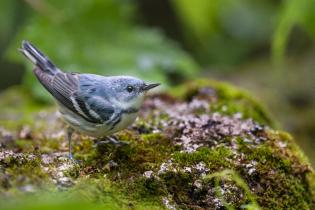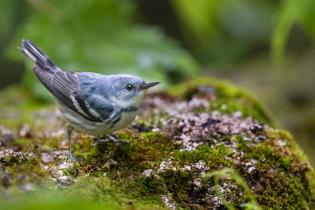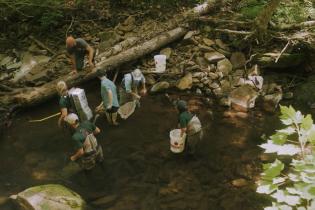
Conserving Diversity of Species
It was here, at the Central Appalachian-Allegheny Plateau, that a remarkably diverse assemblage of freshwater fish, mussels and amphibians survived. Many of these ancient and highly specialized animals still dwell there, making the mountains of New York, Pennsylvania, Ohio, West Virginia, Maryland and Virginia a globally important center of freshwater biodiversity.
The high ridges and valleys snaking through these mountains provide year-round homes and migratory stopover points for many colorful creatures, from candy darters and eastern brook trout to golden-winged and cerulean warblers. Some river systems hold more than 40 species of freshwater mussels, fascinating organisms that employ a variety of techniques to trick fish into dispersing their young.
The region also hosts more species of salamander than anywhere else in the world. Its streams and forests are thought to contain so many salamanders, in fact, that their combined mass would outweigh that of all other small vertebrates combined. Large salamanders called hellbenders hunt in mountain streams, while smaller varieties crawl along the damp forest floor, using neither lungs nor gills to breathe: They simply breathe through their skin.
These amazing creatures face an uncertain future. Urban development, energy exploration, extractive industries, agriculture and other stressors have fragmented and degraded forests. Runoff and the loss of natural filtering systems have impaired the capacity of streams and rivers to sustain aquatic life, while dams and failing culverts have isolated fish and salamander populations.
In 2017, NFWF launched a new, landscape-scale program designed to bring together public and private partners to improve forest and aquatic habitats in this still-vibrant and productive region. The Central Appalachia Habitat Stewardship Program awarded $1.7 million in its first year, providing landowners, local governments and nonprofits resources to balance the needs of the people and wildlife who call those mountains home.
“To sustain the incredible biodiversity of the Central Appalachian region, you need healthy forests and cold, clean freshwater flows,” said Christine Cadigan, director of Northeastern woodland conservation for the American Forest Foundation. “No one agency or nonprofit can operate at the scale needed and across public, corporate and family-land ownership to protect the incredible biodiversity across this region. That’s why collaborative programs such as this are so important.”
Contributing Partners: American Forest Foundation, Richard King Mellon Foundation, U.S. Fish and Wildlife Service, U.S. Forest Service, USDA’s Natural Resources Conservation Service
Contact: Matt Winter, 202-857-0166


